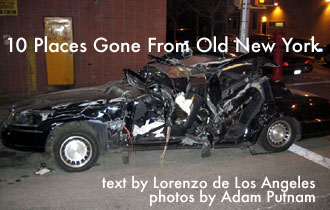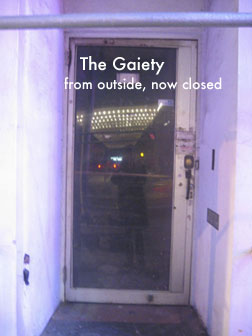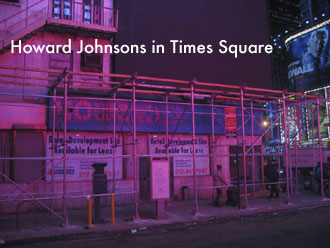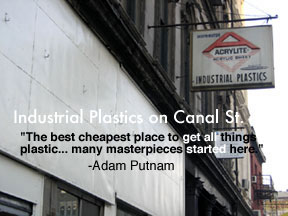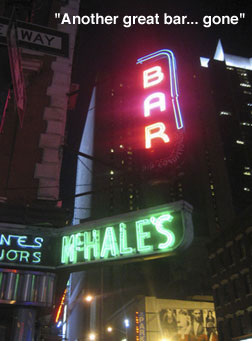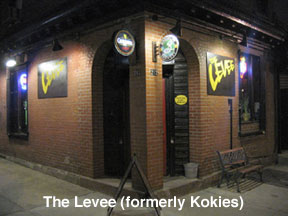10 Places Gone From Old New York
16.04.06
I found this restaurant by accident while apartment hunting in Jersey City. A sign on a grimy, ornate stone facade stating "since 1934" caught my attention. Upon climbing the well-worn marble steps, I was shocked to discover a spacious multitiered room decorated with gold and red art deco Chinese motifs. The atmosphere was heightened further by the blackened windows, low wattage lamps at each table and elderly, tuxedoed, waiters. Used in several film shoots, the restaurant can be seen in To Wong Foo, Thanks For Everything, Julie Newmar and Mickey Blue Eyes. The manager passed away in 2004, leading to a hasty closing. Designated a city landmark, the restaurant remains closed with no reopening date set.
This fabled gay male strip club opened in 1976. Lurid stories abound. During a typical evening, a pornographic film would be shown followed by a group of 12 or so dancers. Each “performer” would step on the runway stage and after a quick introduction (such as "next on stage Chad"), would dance suggestively to upbeat music for about three minutes. He would then exit and remerge completely nude and usually with an erection. Moving now to slower paced music, the dancer would tease the crowd while picking up tips off the stage. The Gaiety closed in 2005 and was located on 46th Street. The entire building will be torn down as part of The Times Square area’s major redevelopment.
Located next door to the Gaiety, Howard Johnson’s was in business for 46 years before closing in 2005. It had a great interior that seemed relatively unchanged since it opened. Light brown leather or Naugahyde banquet seats, Broadway posters from the past, smokey, mirrored columns, orange and dark wood accents and large copper chandeliers with yellowed glass sconces created its unique character. It’s vibrant, welcoming, orange neon sign held its own amongst the modern billboards and chaos on the street.
The Freakatorium opened in 1999 on 57 Clinton Street on the lower east side. It was a small museum that housed the collection of sword sallower, circus/sideshow performer Johnny Fox. Fox’s 20 years of collecting focused on hundreds of morbid and strange artifacts from the nineteenth and early twentieth century, such as shrunken heads, hair wreaths, old weapons, stuffed anomalies, and photographs of famed performers such as Tom Thumb. Every inch of the 400 square foot space held a wondrous object. There were several live creatures housed there too, most notable being Frik and Frak, the two headed turtle. The Freakatorium closed in late 2004 due to rising rents. Johnny Fox told me that he would love to reopen around Times Square and to bring back the "Dime Museum" to that area.
Opened since 1927 and closed in 2004. A spooky party supply and costume shop that was in the shadow of the Flatiron Building. One entered to find a dimly lit space, crowded with dusty items along the walls that had to be retrieved by the staff. Never has a rubber chicken seemed so ominous.
6. Footlight Records
Footlight Records was located on east 12th Street for 27 years until it closed in 2005. Rising rent and the profitability of online sales made the closing inevitable. It was a wonderful, well-stocked store that sold the most seemingly obscure film and stage soundtracks (both foreign and domestic) and recordings of singers known before 1980. It was often an adventure going there and one would always find surprises such as records by Anthony Perkins and Richard Chamberlain.
Located on the second floor of a building on east 8th Street and closed to the public since 2003. Psychedelic Solution opened in the late 80’s and was a poster shop and an art gallery. Gorgeous psychedelic concert, and blacklight posters mainly from the 60’s to the 70’s were sold in the front, while the back room was a gallery that showed artists such as Joe Coleman and Alex Grey. I spent many happy hours and dollars there…
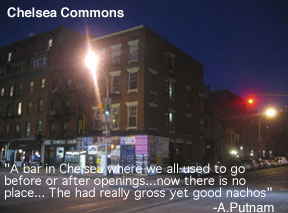 8. A Different Light, Creative Visions
8. A Different Light, Creative Visions
A Different Light, in business for 22 years, closed in 2001. It was one of the three most beloved LGBT bookstores (in addition to Creative Visions and the Oscar Wilde Memorial Bookshop) in New York City. Located on 151 W. 19th, it served the gay, lesbian, bisexual and transgender communities with intelligent, well-stocked selections of literature, both new and old, and also held readings and performances.
Creative Visions, located on Hudson St. closed in 2004. It carried a similar selection of material as A Different Light. However, it was most notable for it’s large archive of vintage photographs, slides, periodicals and other ephemera located downstairs. Taken by generally anonymous photographers of mysterious models, the pictures in that treasure trove were a literal time capsule of the gay experience during the cultural peak of the West Village in the 20th century.
Both stores closed as a result of rising rents, and the profitability of online sales. The Oscar Wilde Memorial Bookshop almost also met this fate, but was saved by generous donors in 2004.
Oh oh Kokies… was located at 212 Berry St. in Williamburg, Brooklyn and closed sometime in late 2003. It was a bar/lounge that flagrantly sold cocaine for almost 3 years. The front door was always locked from the outside. Patrons had to ring a doorbell first and were let in only after the management felt that you were not the police. One then walked casually to the dimly lit back room and stood to the left side. After the transaction was complete, you were encouraged to buy a drink and hang out for a few minutes to avoid the obvious suspicion.
10. Tupelo
Tupelo was a bar that I discovered in my neighborhood in Astoria Queens in early 2004 and quickly became a favorite. It closed in 2005 after five years in business. Although quite young, the bar had the feel that it had been open for many years. The interior was constructed from a variety of old wood doors and was populated by grimy mismatched furniture, peeling painted walls, a brick fireplace filled with candles, small stained glass lamps, and a good sound system that played loud rock music. A video projector occasionally played films, sometimes by local independent filmmakers. The very friendly staff disregarded the smoking ban and were also generous with buybacks. The building that housed this bar was sold and in turn, torn down.
